13 Patio Surface Alternatives That Help You Chill & Impress
Author: Rick Worst | Editor: Omar Alonso
Review & Research: Jen Worst & Chris Miller
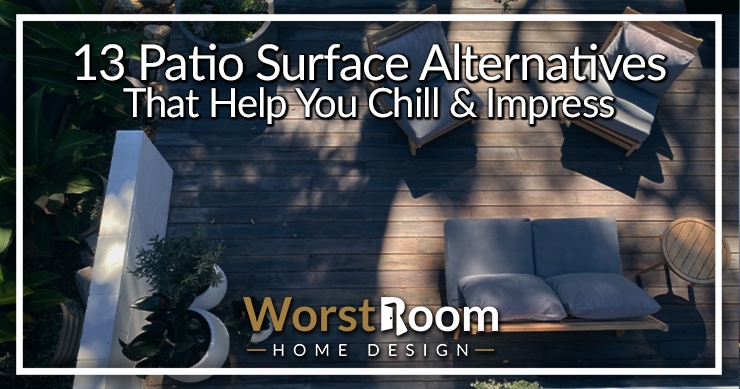
Patio surface alternatives can provide all the benefits of the traditional options without breaking your wallet. Patios provide a great outdoor space for entertaining guests and hosting parties, within the comfort of your homes.
13 Patio Surface Alternatives
The styling and construction of the patio will change depending on what you want to use the space for. The material that you choose for surfacing can help put an individual, creative, and personal twist to your home.
Here are the most popular and reasonable patio surface materials you can check out to liven up your yard. No matter what types of patios you want, you'll find an option here to suit your tastes.
Concrete

Concrete is the most common material used to construct the surface of patios, pool house floors, and anywhere else that will get very wet and weathered. Concrete is a durable material that is a mixture of sand, water, cement, and gravel. All of the ways you can polish, stain, and otherwise customize it makes these great patio surface options.
It is poured onto your patio in one solid piece and is ready for use in two days—one day for pouring and one day for curing. This makes concrete one of the quickest and most hassle-free options to install.
Another great thing about concrete patios is that they can be styled in a variety of ways. The finish can be smooth, stamped, brushed or scored. It can be colored to match your decor. You can even include inlays and patterns into the concrete before it sets.
Despite its versatility in terms of style, concrete patios are low maintenance and highly affordable when compared to other alternatives.
Apart from applying a good sealant every couple of years to prevent cracks, it only needs a thorough sweep or a good rinse with the garden hose once in a while.
The cost of the concrete, as well as the labor cost, also works out much cheaper than other options.
Clay Brick
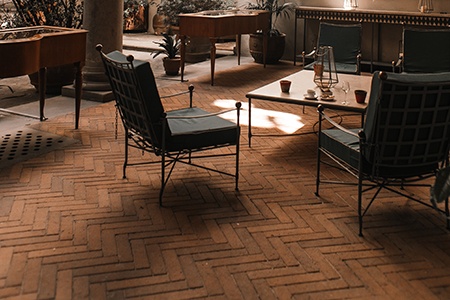
Bricks are made by treating a mixture of clay in a fire kiln. They are a natural and low maintenance option to cover patio surfaces. Since patios are outdoor spaces that are exposed to the elements of nature the color of the patio surface materials tends to fade over time.
However, the natural color of bricks retains their vibrancy even when exposed to extreme weather conditions and does not fade for generations. If you like the style, bricks are the perfect patio surface alternatives.
Now, apart from the traditional brick red color, they also come in shades like pink, grey and brown. You can even mix up different colors to create a unique and stunning design.
Bricks can bear heavy loads, so you can choose quite sturdy pieces of patio furniture without having to worry about cracking the patio floor.
And even if a brick cracks, it can simply be removed and replaced with a new one. Since bricks don’t fade the replacement will blend in with the rest of the flooring as well.
An added advantage is that bricks have naturally rough surfaces, making them safer and slip resistant. Expect to have these bricks hauled in on some types of trailers to your property.
Flagstone
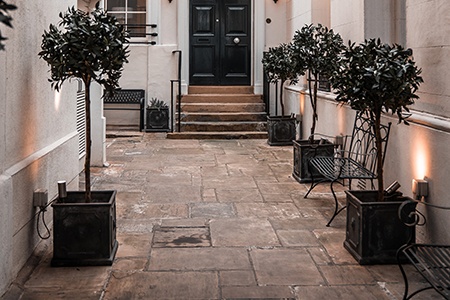
Flagstones are flat slabs of natural stones that are one to three inches thick. They are popular among homeowners because they provide a unique, rustic and elegant look to the patios.
Flagstones are highly versatile, the type of stone you get will vary depending on the stone found in the quarries in the area in which you live. Sandstone, limestone, bluestone and quartzite are some of the common types used in flagstone patios.
Apart from the aesthetic appeal, the rough and unfinished texture of the slabs provides good traction when wet making flagstone patios slip resistant. These stones are also capable of withstanding extreme temperature fluctuations as well.
Since flagstones are natural slabs of stone, their thickness will vary. So when you are creating a patio surface using flagstones you will have to even out the ground using sand, gravel or mortar to get a perfect and durable finish.
Pavers
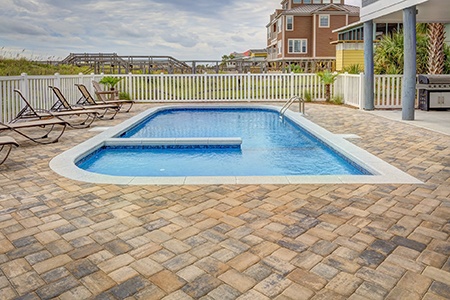
Any types of pavers are great patio surface alternatives to consider when decorating your patio. They come in different shapes and styles, the most common being concrete pavers.
Concrete pavers are made by pouring concrete in molds of different shapes. Dyes are sometimes mixed into the concrete to add some color to the flooring.
Interlocking concrete pavers are a kind of concrete paver that has become quite popular because they are easy to install and maintain. These pavers are molded in such a way that they fit in with each other like pieces of a puzzle.
Interlocking pavers are also more durable than regular pavers because they are more resistant to movement caused by the releveling of the surface underneath.
Unlike some of the other options, like tiles, pavers are extremely durable and can withstand 8,000 pounds per square inch of pressure on top of them. That means you don't need to worry about anything heavy cracking them.
Stone pavers are more common in landscaping because of their aesthetic appeal. These pavers are made from stones like limestone, bluestone, sandstone, granite, and basalt. They're the perfect decking alternatives, in my opinion, and are used as types of landscaping rocks around borders very frequently.
You can even go for a permeable pavement design or your patio. This is a method that leaves space between the pavers to allow infiltration of water and runoff from storms. This will keep your patio from getting waterlogged after storms.
Tiles

Tiles can be used as an attractive and eye-catching flooring option in your patio. Tiles come in a variety of colors and shapes giving you a lot of creative freedom to come up with a visual masterpiece.
It is always best to use unglazed tiles for the majority of the flooring and use the glazed ones for decorating the edges or creating accents. Glazed tiles have a smoother finish that will become slippery in rainy weather.
Porcelain tiles are the most durable unglazed options for patio flooring. Terracotta tiles can be used to create a more rustic and natural look, but these patio surface alternatives can crack if something heavy is dropped on them..
Go for quarry tiles if you live in an area that gets a lot of rainfall, as these tiles have rougher surfaces that provide better traction when wet.
Cut Stone
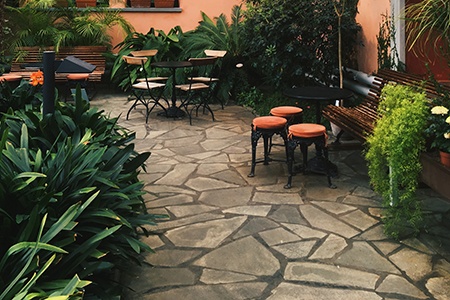
Cut stones are tile made of natural stones cut into rectangular or square shapes. They are different from flagstones which are more unique and irregular in terms of cut and size. Since they are uniform in size and thickness, cut stone tiles are much easier to install.
The best part with these is you can use stone types of chisels or types of saws to shape the stones however you like. Because you'll definitely be building a puzzle here more than anything else, trying to fit the pre-shaped stones into place. You'll have to create sizes of your own at some point.
Just like flagstones, these patio material options also come in a variety of natural colors, lending an air of authenticity and elegance to your outdoor space. Unlike concrete and brick that look uniform and boring, cut sones help add some character.
Cut stones are natural, meaning labor and resources have not been spent on manufacturing them. This makes them an environmentally friendly and sustainable option than other alternatives. If you get them thick enough you can use them to build natural stone steps too.
Even though they are more expensive, cut stone tiles last for a long time making them a long-term investment, which is why they're used as exterior house stone veneers, too. Once they crack or crumble, they can be crushed and used to make aggregate for concrete mixes so that there is no waste of resources.
Slate Stone
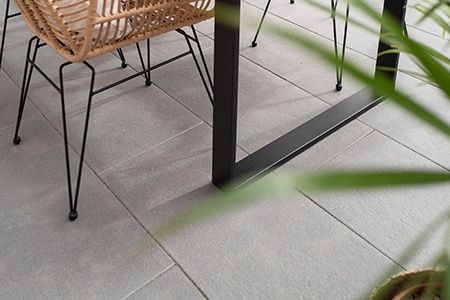
Slate stone are very similar to cut stones but instead of randomized shapes, these are typically square or rectangle and all uniform in size. You lay them with spacers and grout like you would with tile.
They're a great DIY option, and they're very durable. You'll have a lot of color options and styles, and can scrub them with a brush or even pressure wash to clean them. If you like expensive outdoor furniture, these patio surface alternatives can really turn the sophistication up a notch.
Gravel

Gravel refers to a loose collection of small rocks or stones. Filling your yard or patio with gravel is much cheaper than installing some kind of flooring. These also do not need much maintenance or care making them the perfect combination of low budget and low maintenance.
You will need to install a wooden frame along the patio borders to keep the loose gravel within the patio. Typically, you would layer smaller stones like pea gravel on top of a bed of large gravel to make drainage easier.
An added advantage of using gravel to cover your patio is that it will allow water and runoff from rainfall to seep into the ground. Not only does this prevent waterlogging but it also helps replenish the water table. That's a bonus that most patio material options don't have.
Sand

Sand is another loose material, like gravel, that you can choose for your patio surface. You will need to install a wooden frame before filling in the sand. This may be the best patio surface material if it's up your alley. Otherwise you may really not like it.
Just like with the gravel you will need to provide a bed of large gravel underneath before pouring in the sand. The sand bed will have to be at least 4 inches deep.
On top of being low cost and low in maintenance, sand patios offer all the feels of a beach without actually having to go to the beach. This makes it an excellent choice for throwing themed parties.
Wood Mulch
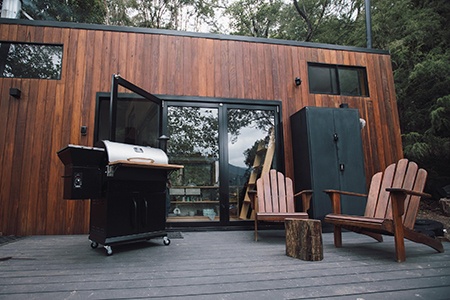
Wood mulch is another loose material that can be used as a low-cost alternative to traditional patio flooring options. Just like the previous loose material options, mulch patios also require to be boxed in with a wooden frame with a layer of large gravel as the base.
I like the nonchalant, simple aesthetic this brings. Imagine having a small fire pit, building a pallet adirondack chair, and kicking back with the buddies for good conversation in the cool evening. You can't beat these as patio surface alternatives.
Patio Mats
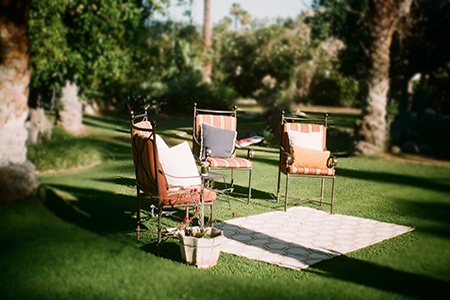
Patio mats or outdoor rugs will help you spruce up your old and worn out concrete patio flooring. They come in a variety of colors and designs. They can be easily moved from one location to another, are durable, can get wet, and more.
Getting patio mats are less expensive than redoing the entire patio flooring. You can consider getting these mats if your existing flooring has worn out but not enough to justify spending lots of money to replace the whole floor.
Loose Materials
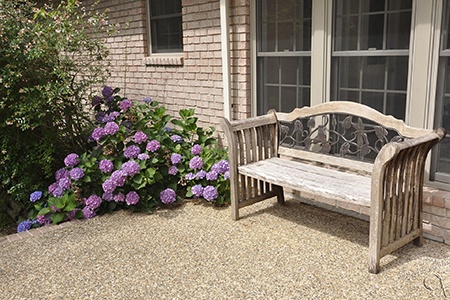
Loose materials refers to patio surface options like mulch alternatives, sand, rubber mulch, pebbles, crushed stone, pea gravel, and much more. My neighbor has one made out of bark mulch that looks amazing with the wooden pillars and shutters he has.
Mixed Materials
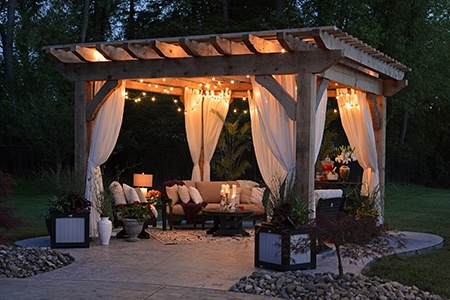
There are no hard and fast rules that say you need to stick to just one of the above methods when decorating your patio floors. You can combine utility and aesthetic appeal by mixing two or more of these options in a planned manner.
By mixing up materials you can also cut down on costs and find a combination that fits your budget.
Patio Surface Alternatives for Every Taste & Budget
Choosing a flooring material will depend on the location of your home, The size of your patio, your budget and availability of materials. What matters is that you choose patio surface alternatives that reflect the style and feel of your home.
You'll Also Enjoy:
- 43 Types of Marble With Unique Features That Can Impress Anyone
- 11 Stair Measuring Tools for Fast, Safe, & Accurate Work
- 26 Types of Clamps & Their Uses in All Project Sizes [Pics]
- 13 Types of Plywood: Grades & Prices for Your New Project
- 7 Plywood Alternatives That are Sturdier, More Resistant, & Cheaper



